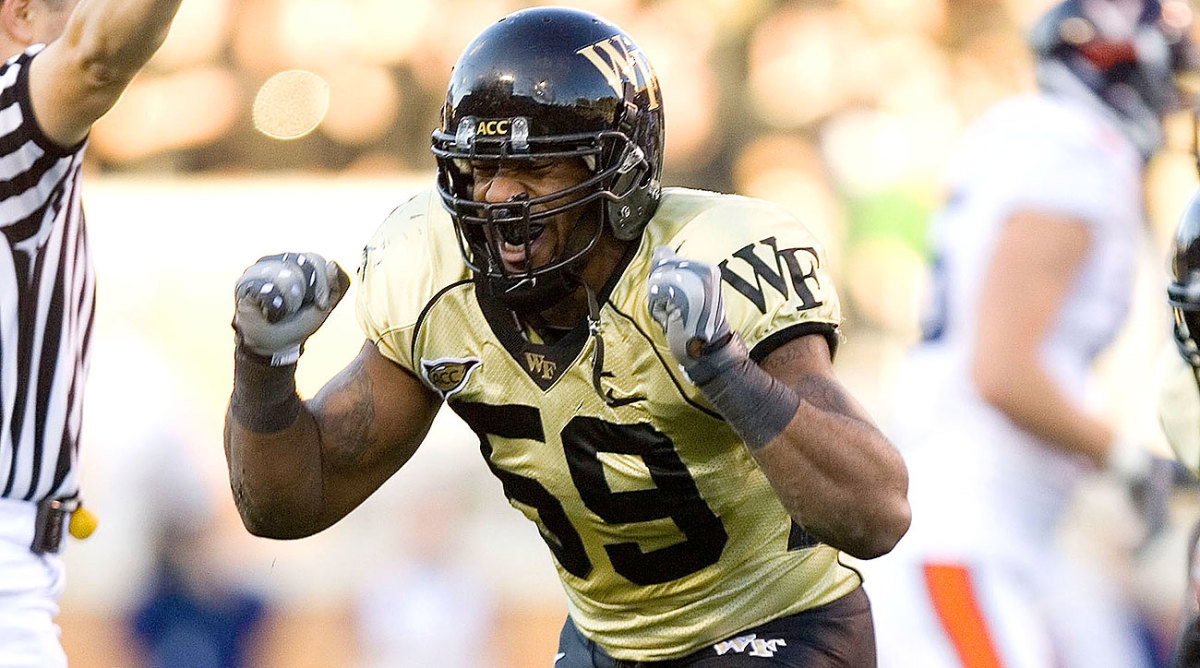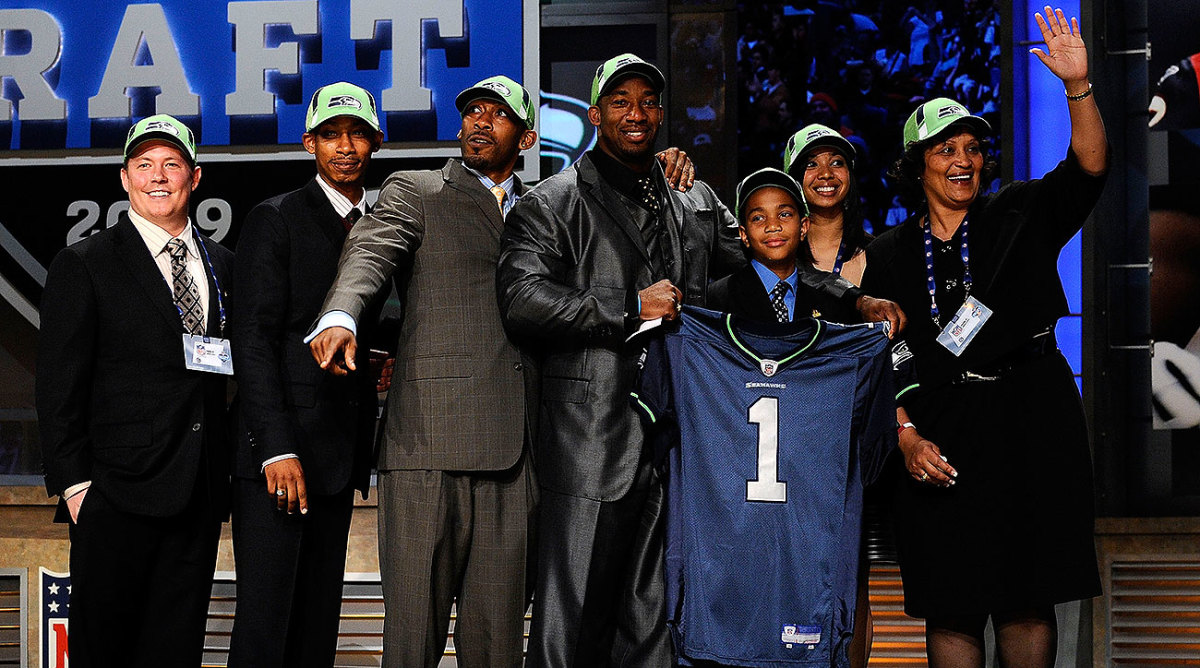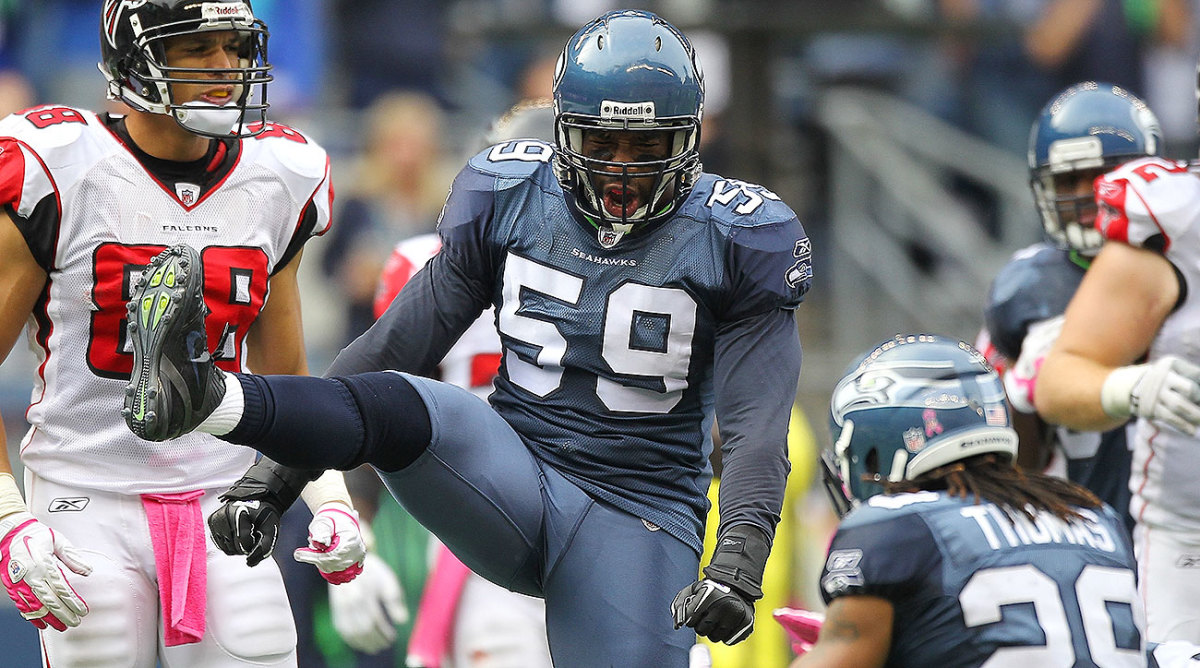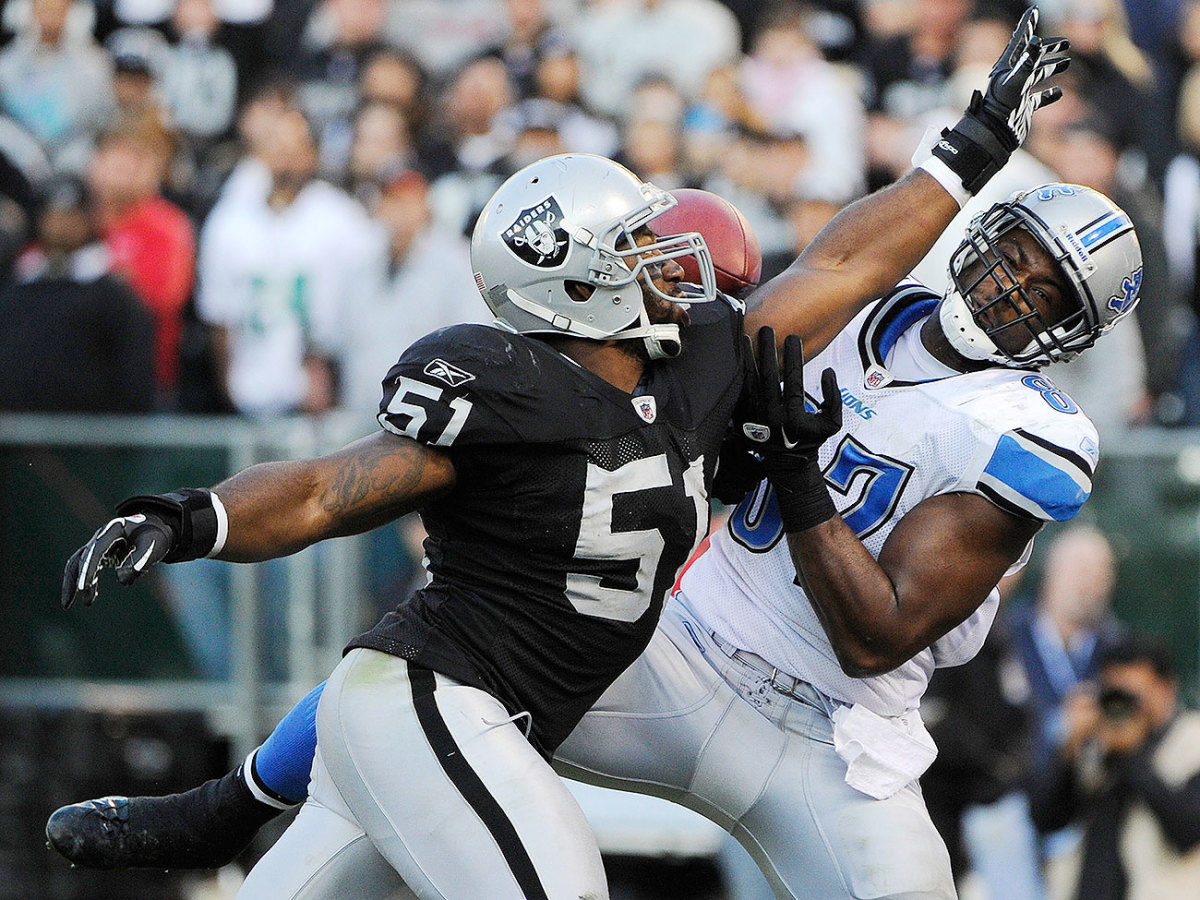An NFL draft bust's new perspective: How Aaron Curry is putting lessons learned to good use

CHARLOTTE, N.C. — Aaron Curry wouldn’t be a football coach without quotes or props surrounding him. He wears a green wristband bearing a scripture from Ephesians. His office features wrestling championship belts in the corner and a tombstone on top of cabinets reading “R.I.P. Excuses.” On the whiteboard in red marker, there’s scripture from Proverbs.
“The lazy man will not plow because of winter; He will beg during harvest and have nothing.”
That’s the kind of quote the current UNC Charlotte defensive line coach lived by as a teen, literally working hard in the figurative cold winters. Growing up poor in Fayetteville, N.C., it didn’t get sunny for Curry until 2009, when the Seahawks drafted him fourth overall and signed him to a contract worth up to $60 million.
That’s also the kind of quote that UNC Charlotte DT Larry Ogunjobi lives by now. Ogunjobi, unquestionably the greatest football product to come out of the young 49ers program and a likely second-day pick next month, is Curry’s first protégé as a coach.
2017 NFL draft rankings: Top prospects by position
But as a football player, Curry was the can’t-miss prospect out of Wake Forest—the best player to ever come out of that program. Though, after four disappointing years, he was officially a draft bust. If Curry were a quarterback, there’d probably be a ESPN 30-for-30 on him already.
“Nobody cares about linebackers. Linebackers are a dime a dozen,” Curry says, “until you find Von Miller.”
Since 2000, only three linebackers have been taken in the first four picks of a draft: LaVar Arrington, Curry and Miller. Arrington was a three-time Pro Bowler, Miller is a Super Bowl MVP and Curry lasted four years with three different teams before calling it quits.
Here’s what he knows now, and what he tells the next generation led by Ogunjobi: For the two most crucial years of his NFL career, he didn’t plow in the winter.
In his senior year of high school, Curry, now 31, was about 6' 2" and 195 pounds. The youngest of three boys whose mother was a high school science teacher, he had the typical teenage metabolism but was only able to eat the little that was available to him. The eggs he had, he’d either boil them or drink them raw. He slathered bread with peanut butter, and cooked up instant mashed potatoes. Wherever he could find protein and carbs, he tried to take them in as efficiently as possible. There wasn’t much to go around, so Curry had to get creative with what he did have.
“I grew up not knowing or being guaranteed breakfast, lunch and dinner. You eat school breakfast and lunch, but that wasn’t much,” Curry said. “That was probably the best thing that happened to me, because it forced me to develop a mindset. I knew I’d be smaller than everybody as far as girth, so I had to have a different mindset. I had to approach everything differently. I had to be a step faster, be more aggressive, know what I was doing to put myself in a position where I could dish out punishment even though I may have been out-sized.”
Patriots give Tom Brady his best receiving corps in years by adding Brandin Cooks to the mix
East Carolina was the only local school recruiting Curry in his senior year, but Wake Forest caught on late. Then-linebackers coach Brad Lambert watched Curry’s tape during Christmas break and took a trip to Smith High School in January to meet Curry, who (of course) was in the weight room when he was called to the front office. Lambert and the Demon Deacons offered him a scholarship just three weeks before signing day, believing Curry would be able to put enough weight onto his big frame to hang in the ACC.
Boosted by the Division-I training facilities and a student-athlete meal plan in Winston-Salem, Curry finally put on the pounds and trained harder than ever before. The player that Deacons’ fans and opponents saw on Saturday during games was the same player that Lambert and the team saw at Tuesday’s practice.
“I’ll never forget being a freshman and an older guy tried to talk me out of being full speed at practice. I couldn’t grasp the concept. It didn’t make sense to me,” Curry said. “To me football was just football, whether you practicing or playing on Saturday.
“I knew you couldn’t show up on Saturday and expect to be this great player. Well, I knew I couldn’t. I couldn’t afford to.”

Curry was a three-time All-ACC player with 29 1/2 tackles for loss in his final two seasons. He won the Butkus Award for top linebacker in college football in 2008, and he ran a 4.52 40-yard dash at the NFL combine while weighing 254 pounds. There was little doubt his skills would translate to the pros, but there was a question no one could answer.
“The question I got a lot through the evaluation of him as an NFL prospect was, because at that time they didn’t have [rookie contracts] slotted from a financial standpoint, how will he handle the money,” Lambert said. “He signed a big contract, and you never know. How do you answer that question? I don’t know.”
The 2009 Seahawks were destined to be a mess. Mike Holmgren had guided the Seahawks to five straight playoff appearances, including a loss in Super Bowl XL. He announced before the start of the 2008 season that it’d be his last with the Seahawks, and Seattle tabbed the younger Jim Mora as the coach-in-waiting. Seattle went 4–12, its worst season since 1992, and got the No. 4 overall pick.
The 2009 draft was the first in 10 years without Holmgren in the building—Mora and Tim Ruskell were running the show. The Seahawks were rumored to be drafting QB Mark Sanchez out of Southern Cal to compete with Matt Hasselbeck, who was coming off an injury-shortened season during which he doubled his touchdowns (five) with interceptions (10).
But despite already having linebackers Lofa Tatupu, Julian Peterson and Leroy Hill, Seattle took Curry with the fourth overall pick. Surrounded by 20 family members who had traveled to New York with him, Curry broke down in tears, realizing his dream had come true. He inked a six-year contract worth up to $60 million, ensuring that no one in his family would need to eat instant mashed potatoes again.
The following weeks were a blur, and the plane trips to Seattle were as frequent as car rides down the street. But once things settled down, Curry looked at the map and realized he couldn’t be playing in the NFL farther from home.

As Curry’s rookie season began, he didn’t understand how to ride the roller coaster of emotions that come with playing in the NFL. Seattle started with a 28–0 win against the Rams, and 15 weeks later the Seahawks were 5–11 with nine of those losses by more than one score. Curry let the low points of the season sink him, and he realized his lifelong goal had forsaken him.
“One of my motivations was being able to change the financial dynamic of my family,” Curry said. “But if you have a motivation that can be gained, what do you now? My goal was to get paid, and I got paid. And me looking back on it now, I got what I wanted. Now what? I look back on it and I realize I was a victim of having a motivation that wasn’t everlasting, that wasn’t going to keep me going when things got hard. I had a goal that wasn’t fulfilling.
“I went and got exactly what I wanted, and as soon as I got it, I put it in my pocket and I was like, ‘Oh, you guys need something else?’ That’s where I lost my way. In college it was like I’m going to keep grinding ‘til I get it. And then I got it.”
Curry finished fourth on the team in tackles that season with 53, and he had six passes defensed but just two sacks. The next year under new head coach Pete Carroll, Seattle snuck into the playoffs at 7–9, and Curry finished sixth in tackles (57) and marginally improved in sacks with 3.5.
Hasselbeck noticed the pressure of not delivering as a top pick wearing on Curry. The QB invited Curry to Bible study, and along with running back Justin Forsett, Hasselbeck helped keep Curry’s hopes up in those trying first two seasons.

Hasselbeck has long thought that Curry’s struggles in Seattle had a lot to do with Gus Bradley’s Tampa 2 defense that had Curry playing in space. Maybe if Curry had gone to a 3–4 defense he would have had a longer NFL life. But Hasselbeck, now an ESPN analyst for Sunday NFL Countdown, can also see things from Curry’s perspective.
“I felt that in high school where kids chase a dream of getting a scholarship and then they get the scholarship and then they’ve accomplished their goal,” Hasselbeck said. “You see husbands do it where they’re the king of landing the prettiest girl they can find as a wife. They date her to death. They’re amazing at dating her, and then they get married and then it’s like what’s next? That’s when the journey has just begun. It’s similar in the football world. When you get drafted, you’ve really done nothing, essentially.”
Rookie K.J. Wright took Curry’s starting job two weeks into the 2011 season, and in an almost unprecedented move, the Seahawks decided they had seen enough of their No. 4 pick from 29 months earlier. Seattle traded Curry to Oakland for a seventh-round pick, and the Raiders re-worked his contract.
The placekicker puzzle: Why it's one of the toughest positions for NFL scouts to evaluate
In Oakland Curry kept a detailed notebook of what he wanted to improve in his second act. He was going to better commit his time to football. He’d get to the facility early and stay late. More film study, better nutrition, a more disciplined schedule, the works. It worked for the 2011 season, until both of his knees gave out on him.
Curry tried stem-cell therapy while he was on the physically unable to perform (PUP) list during the 2012 season, but he could never get right. He signed a one-year deal with the Giants before the start of 2013, but he didn’t even make it past the first round of training camp cuts. When he saw his phone ring, he asked his wife Jamila to have things packed when he returned from the facilities to drop off his playbook.
“From OTAs to minicamp through training camp I was watching the film saying I’m not the player I was two years ago in Oakland,” Curry said. “I can see and feel it the same way, but I can’t change direction and I can’t drive off my first step and go make this play. I can’t get downhill as fast as I used to. When I saw that, I was like well, to me my time is up—whether they cut me or whether someone comes over and knocks me out because I can’t get out of the way.”

Curry had spent the offseason training at UNC Charlotte, where Lambert, formerly his position coach at Wake Forest, had taken over as the school’s first-ever head football coach. He called Lambert and asked if he had a spot on his staff open, and Lambert cautioned Curry to take a week or so and talk to his wife, Jamila, about whether the coaching life would be the best thing for him and his family.
Jamila gave her blessing, and about 10 days later, Curry called Lambert and said he wanted in. The 49ers kicked off their inaugural season, and Curry joined the team’s strength and conditioning staff as an intern.
Ogunjobi was easy for Curry to spot. When Curry was in Charlotte training before Giants’ camp in 2013, he’d watch the 49ers condition on the field. When everyone went inside the building, Ogunjobi stayed outside to run the stadium stairs.
Ogunjobi is from Greensboro, about 40 minutes from Wake Forest where Curry shined. But Ogunjobi had never heard of Curry because he didn’t start playing football until his sophomore year of high school. So in 2013 as Charlotte and Ogunjobi prepared for their first year of collegiate football, the young defensive tackle took every opportunity to pick Curry’s brain.
“What made you different?” is the question Ogunjobi had for Curry. The former No. 4 pick told his pupil that there’s selfishness in greatness, and that you must be willing to be alone if you’re going to be at the top. If you know that you’re the best, then it’s not about proving it to anyone else. It’s about proving it to yourself.
“Understanding that the man who says he can and the man who says he can’t are both right,” Ogunjobi said. “I knew I was going to outwork and outlast everybody, but now it’s are you better than the Larry yesterday, or did you take a step back? Did you relax too much? He helped me in that aspect.”
NFL scouts on the prospects who impressed—and disappointed—at this year's combine
After a year as a strength intern, Curry became a grad assistant helping with linebackers in 2014. For the past two seasons he’s served as the defensive line coach, a role Lambert had no reservations about because he knew Curry would study what it took to be a great coach.
Ogunjobi made the all-conference teams in his final two seasons under Curry’s tutelage. He’s the school’s all-time leader in tackles (217), tackles for loss (49) and sacks (13). At 6' 3" and 305 pounds, Ogunjobi ran a sub-5 40 at the combine and put up 26 reps on bench press. He could be drafted as early as the second round next moth.
“He is driven by something that ain’t ever going to be taken from him. It doesn’t have an ending to it,” Curry says. “He wants to be the best ever. One of his goals was to be the best to ever play here. He’s a guy who, because he wanted to be the best, I could be completely honest and truthful with him because he knew his goals mattered to me. I could coach him just as hard as I coach anybody else, and that made it easier in the room.
“When the best player in the room buys in, everybody buys in. When you look at the best player in the room and you say, ‘Hey Larry, this is not a good rep,’ and he responds, ‘Yes sir I’ll fix it,’ it helps everybody.”
NFL free agency grades: Analyzing the biggest moves of the new league year
Now Curry has a new professional goal to be the best to ever coach the game. But it’s more than that. For everyone he coaches, he wants that player to raise young men that his daughter, Aaryn, can date. He coaches with a passion because he wants to be a positive male influence on every young man he encounters. To Curry, if he can help put stronger, more well-adjusted men into the world, society will be better.
This is where his journey from fourth overall pick to position coach at an upstart program has taken him. Yes, he was an NFL bust and any Google search will confirm that. But that experience got him to where he is today as a husband, father of four and football coach.
“My son is going to type my name into Google and ask ‘Dad what does bust mean?’ And I’m going to say, ‘Let me sit you down and let me tell you about a three- or four-year span of my life that created what we have now and what you have now,’” Curry says. “My kids have no clue that a lot of my parenting comes from what I learned in the NFL. What it takes to be successful, whether it’s sports or first-grade math.
“You have to work hard, practice, pay attention to details. You can’t show up and just think you’re going to be good at first-grade math. You have to work really hard at this.”
